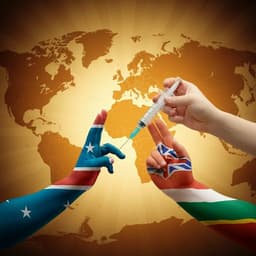
Medicine and Health
Racial Health Disparities and Black Heterogeneity in COVID-19: A Case Study of Miami Gardens
Y. Paat, M. C. E. Orezzoli, et al.
This study, conducted by Yok-Fong Paat, Max C E Orezzoli, Chun-Kit Ngan, and Jeffrey T Olimpo, investigates the risk and protective factors encountered by residents in Miami Gardens during the COVID-19 pandemic, shedding light on racial health disparities and the unique challenges faced by the Black community.
~3 min • Beginner • English
Introduction
The study investigates how the COVID-19 pandemic has disproportionately affected Black communities in the United States, focusing on racial health disparities and Black heterogeneity within Miami Gardens, Florida. Framed by evidence of systemic inequities in healthcare access, socioeconomic conditions, and comorbidities that elevate risk among Black Americans, the research aims to understand risk exposure, protective behaviors, infection experiences, vaccination intentions, assistance needs, and mental health experiences among residents. The purpose is to generate insights that can inform targeted, culturally responsive public health interventions for Black Americans and Afro-Caribbeans in a predominantly Black municipality.
Literature Review
The literature links COVID-19 racial health disparities to structural disadvantages, including inequities in healthcare access/utilization, economic deprivation, environmental risks, and comorbidities. The Social Determinants of Health framework explains how factors like income, housing, healthcare access, and neighborhood conditions shape health outcomes. Black communities are more likely to live in disadvantaged, segregated neighborhoods with environmental hazards and fewer healthcare resources; face higher unemployment, lower wages, lower educational attainment, and reduced insurance coverage; and experience discrimination and implicit bias in healthcare, leading to mistrust and reduced utilization. Blacks are overrepresented in frontline/essential roles with higher exposure risks and less opportunity to work remotely, making social distancing harder, especially in multigenerational households and dense neighborhoods. Minority stress and racism-related stressors contribute to adverse mental health outcomes; social isolation during the pandemic exacerbates loneliness, depression, and anxiety, though faith and community networks can bolster resilience. Black heterogeneity is often overlooked; Afro-Caribbeans, a large subset of Black immigrants, remain understudied. Prior work documents elevated COVID-19 cases, hospitalizations, and mortality among Black populations and highlights the need for culturally competent communication and interventions.
Methodology
Design and setting: Cross-sectional survey of residents in Miami Gardens, Florida, a predominantly Black city. Recruitment and period: Convenience and snowball sampling via emailed invitations (with assistance from City of Miami Gardens officials and Live Healthy Miami Gardens) from late January to early February 2021. Eligibility: Aged 18+ and resident of Miami Gardens. Ethics: IRB approvals from the University of Texas at El Paso and Florida Memorial University; participation was voluntary and anonymous with informed information provided online.
Sample: n = 83 participants; 72.3% completion rate; average completion time ~9 minutes.
Instrument: Online questionnaire (QuestionPro) with 54 closed-ended items covering sociodemographics, protective measures, COVID-19 testing/diagnoses/vaccination history, health behaviors, and assistance needed/received; plus one open-ended question (31 responses).
Quantitative analysis: Descriptive statistics computed in SPSS 27; results visualized (pie charts). Between-group comparisons (Black vs non-Black) and within-group comparisons among Black participants (Black Americans vs Afro-Caribbeans) examined risk exposure, protective measures, testing/diagnoses/vaccination, and assistance.
Machine learning feature selection: Four supervised feature selectors in Weka—ReliefF Ranking Filter, Correlation Ranking Filter, ZeroR Classifier Feature Selector, and Correlation-based Feature Selector. Ensemble approach: intersected outputs to form sets of variables significant to each racial group; ranked features by number of ML models selecting them. Target variable: racial group (Black vs non-Black).
Qualitative analysis: Thematic analysis of open-ended responses to identify repeated patterns, themes, similarities, and differences; selected quotes presented due to small qualitative sample.
Key Findings
Sample profile: 83.1% identified as Black; 20.6% of all participants identified as of Caribbean descent; 23.8% identified as Caribbean/West Indian; 15.7% male; mean age 52.9 years; 63.2% college graduates; 58.8% employed full-time; ~40% married; average household size ~4 (about one child); 8.6% Hispanic.
Risk exposure: Compared to non-Black participants, Black participants more frequently engaged in activities increasing exposure risk (e.g., attending gatherings, dining out, bars, salons, tourism, working outside home, smoking). From ML Level 2 examples: drinking at a bar (Black 11.6% vs non-Black 0%); getting nails done (43.5% vs 14.3%); attending a house party/gathering with >5 people (20.3% vs 7.1%). Within Black subgroup, Afro-Caribbeans more likely to frequent tourist locations; Black Americans less likely to work remotely.
Protective measures and infection: Black participants were more likely to adopt preventive measures (handwashing, physical distancing, quarantining) than non-Black participants yet also more likely to test positive for COVID-19 and/or have household members who tested positive. Within Black subgroups, Afro-Caribbeans more frequently took protective measures but had higher positivity for themselves/household.
Vaccination: Black participants were less likely to plan to be vaccinated, more likely to refuse, and more often undecided, despite higher infection rates.
Assistance needs: Black participants more likely to need employment assistance, mental health counseling, housing, and childcare; non-Black participants more likely to report needs for food and financial assistance. Within Black subgroups, Black Americans expressed greater need across services than Afro-Caribbeans. Selected table values: services currently received—childcare assistance Black 1.5% vs non-Black 14.3%; services needed but not received—financial assistance Black 23.2% vs non-Black 28.6%.
Machine learning feature selection (Table 5): Level 1 features (selected by ≥3 models): washing hands with soap to protect self (Black 100% vs non-Black 92.9%), washing hands with soap to protect others (98.6% vs 78.6%), currently employed working from home (30.4% vs 50.0%). Level 2 features (selected by 2 models): average weight increased less among Black participants (2.0 vs 5.3 lbs), Black participants more likely to feel indifferent since/after COVID-19 (mean 2.1 vs 1.8), less likely to receive childcare assistance (1.5% vs 14.3%), more socially engaged (higher rates of certain social activities).
Mental health and emotions: Compared with non-Black participants, a smaller proportion of Black participants reported anxiety, anger, fear, and hopelessness; a greater proportion reported feeling lonely and indifferent. Overall, both groups rated their physical and mental health less positively since the pandemic.
Qualitative insights: Participants voiced needs for services and vaccination, but many also expressed gratitude and hopefulness, indicating resilience and adaptive coping.
Discussion
Findings confirm racial and ethnic disparities in COVID-19 exposure risk, infection, access to services, and mental health experiences in a predominantly Black community. Despite higher adoption of protective behaviors, Black participants—especially Afro-Caribbeans—reported higher infection rates, suggesting that structural factors (e.g., occupational segregation limiting remote work, household density, cultural and religious gatherings, transportation reliance) may offset individual-level precautions. The study highlights elevated assistance needs among Black participants (employment, housing, mental health, childcare) and underscores the importance of addressing social determinants and structural racism to mitigate disparities. Emotional profiles and qualitative responses suggest notable resilience within Black communities—possibly supported by social connectedness and faith—while also revealing loneliness and indifference during prolonged distancing. Lower vaccination intentions among Black participants align with broader evidence of mistrust and hesitancy, emphasizing the need for culturally responsive, trust-building public health communication and tailored interventions that recognize Black heterogeneity (Black Americans vs Afro-Caribbeans). Overall, the results provide actionable insights for targeting resources, improving access, and designing interventions that account for both structural inequities and within-group diversity.
Conclusion
This case study of Miami Gardens provides preliminary evidence that, even with higher adherence to protective measures, Black residents faced greater exposure risks and higher infection rates, particularly among Afro-Caribbeans, and experienced distinct assistance needs and mental health profiles compared to non-Black residents. The integration of descriptive analyses with ML feature selection identified key differentiators (e.g., handwashing adherence, remote work limitations, social engagement patterns) between Black and non-Black participants. The study underscores the necessity of addressing structural determinants, enhancing culturally competent communication, and designing targeted, community-engaged interventions that acknowledge Black heterogeneity. Future research should incorporate nativity and immigration status, expand sample size and representativeness, and more deeply examine mechanisms underlying higher infection despite protective behaviors, including workplace exposures, household characteristics, access to care, and vaccine hesitancy.
Limitations
Convenience and snowball sampling with a small sample (n = 83) limits generalizability and the ability to conduct in-depth between- and within-group comparisons. Self-report introduces social desirability and recall biases. Nativity/immigration status was not collected, hindering analyses of immigrant-related heterogeneity among Afro-Caribbeans. Findings should be interpreted cautiously and viewed as preliminary. Future studies should collect nativity data and employ more rigorous sampling to capture Black heterogeneity and improve external validity.
Related Publications
Explore these studies to deepen your understanding of the subject.







